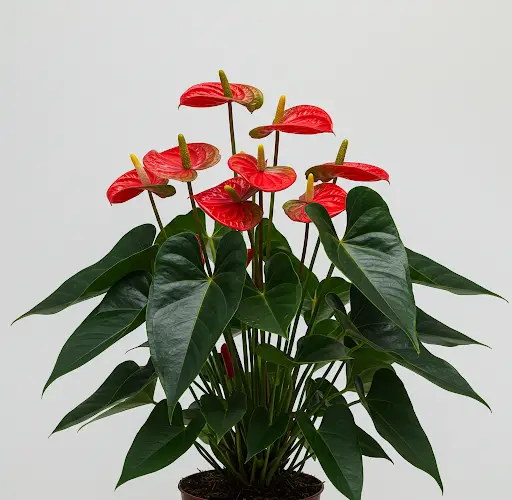How to Keep Your Anthurium Healthy and Vibrant
Anthuriums are stunning tropical plants that add a touch of elegance to any home. Native to Colombia, these plants are also known as “flamingo flowers” due to their unique appearance. The name Anthurium comes from the Greek words “anthos” (flower) and “oura” (tail), which refers to their distinctive shape.
Different Anthurium Varieties
There are various Anthurium varieties, some of which have been genetically modified for improved characteristics. The most common is the red Anthurium, followed by the white and pink varieties. There are also rare types like the deep purple, dark green, yellow, orange, and speckled pink Anthurium. All of them thrive in tropical climates and share broad, thick leaves.
Many people don’t realize that the brightly colored part of the Anthurium is not actually a flower but a modified leaf. The real flowers are tiny and found on the spike in the center of this modified leaf. These vibrant leaves help attract pollinators since the actual flowers are small and unnoticeable.
How to Propagate Anthuriums
If you want to grow new Anthuriums, the best method is by division. Over time, multiple shoots develop in a single pot, making it easy to separate them into new plants. When dividing, gently loosen the roots from the soil and carefully separate the shoots. It’s best to do this on a cloudy or rainy day to minimize plant stress. Anthuriums thrive in fibrous materials like coconut husk or tree fern fiber, which provide excellent aeration for their roots.
After separating, replant the new shoots in a well-draining potting mix or coconut fiber. The plants will establish themselves more quickly and produce lush foliage.
Why Do Anthuriums Lose Their Color?
If your Anthurium starts losing its bright color, it is often due to aging. Older flowers naturally fade, while new ones emerge in vibrant shades. However, insufficient light can also cause color fading. These plants require indirect sunlight, preferably in the morning between 6 AM and 9 AM. Avoid placing them in full sun, as excessive exposure can burn the leaves and flowers, leading to unsightly brown patches.
To ensure consistent blooming, place your Anthurium near a window, on a shaded porch, or in a well-lit indoor space. Proper lighting stimulates flower production and keeps the plant looking its best.
How to Revive a Stressed Anthurium
If your Anthurium has yellowing leaves, brown spots, or signs of stress, it may need a new environment. Consider repotting it in fresh soil and moving it to a spot with bright, indirect light. If the plant has lost too many leaves, trim the damaged ones and allow it time to recover.
The Best Organic Fertilizer for Anthuriums
To keep your Anthurium thriving, a balanced fertilizer is key. One of the best natural fertilizers includes two simple ingredients:
- Castor Cake (Torta de Mamona) – This is an excellent source of nitrogen, which promotes leafy growth and overall plant health. It helps develop lush, green foliage and strong stems.
- Wood Ash – Rich in phosphorus and potassium, wood ash encourages robust flowering and strengthens plant resistance.
For application, mix one tablespoon of castor cake with one tablespoon of wood ash. Apply this mixture every 20 days by placing it near the plant’s base and covering it with soil. This ensures a steady nutrient release without overwhelming the roots.
Preventing Common Anthurium Problems
- Rotting Stems – If the base of the plant turns mushy, it could be due to bacterial or fungal infections. To save the plant, remove it from the soil, let the roots dry for two days, and then replant in fresh soil.
- Spots on Flowers and Leaves – Brown or white spots on the flowers and leaves often indicate excess moisture. When watering, avoid wetting the leaves and flowers, focusing only on the soil.
- Pest Infestations – If you notice snails, slugs, or small insects on the plant, regularly check the soil for eggs. Keeping the area around the pot clean helps prevent infestations.
Growing Anthuriums Indoors
Anthuriums adapt well to indoor environments, even in air-conditioned spaces. However, if the leaf tips start browning, it may be due to excessive dryness or overwatering. To maintain healthy foliage, water the plant only when the top layer of soil feels dry.
These plants are a favorite among plant lovers due to their unique beauty and low maintenance requirements. Whether you prefer red, white, or pink Anthuriums, proper care ensures they remain vibrant and healthy year-round.
By following these simple tips, you can enjoy beautiful, long-lasting Anthurium blooms in your home!



